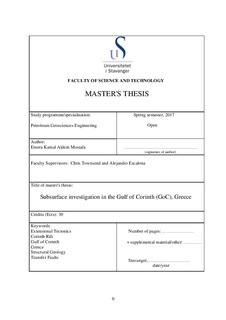| dc.contributor.advisor | Townsend, Chris | |
| dc.contributor.advisor | Escalona, Alejandro | |
| dc.contributor.author | Mostafa, Emera Kamal Aldein | |
| dc.coverage.spatial | Gulf of Corinth, Greece | nb_NO |
| dc.date.accessioned | 2018-01-15T11:49:41Z | |
| dc.date.available | 2018-01-15T11:49:41Z | |
| dc.date.issued | 2017-08-11 | |
| dc.identifier.uri | http://hdl.handle.net/11250/2477487 | |
| dc.description | Master's thesis in Petroleum Geosciences Engineering | nb_NO |
| dc.description.abstract | Corinth Rift is an excellent rift laboratory to study the rift processes occurring during the early and late stages of continental extension due to exposure of a series of half-graben structures at the southern margin. Segmentation and lateral variation along the strike in the rift were observed in several studies, where the lateral correlation is hard to obtain as the W-E faults terminated in the valleys and became difficult to trace.
The boundaries between the segments were less emphasized and developed as the main focus of the previous studies was the N-S direction of the rift. The structure geometry is still an going debate and has been interpreted in several ways with some of the studies proposed it to be a relay ramp, and others suggested a transfer zone.
2D seismic, bathymetry, earthquake, and onshore data was used to investigate if the segmentation continues offshore. Furthermore, to reveal the structures the boundaries between the segments, where W-E lines were the main focus throughout this study.
The evidence of the segmentation of the Gulf was substantial as several NNE-SSW faults were traced in W-E seismic lines, some of those faults were correlatable with proposed previous studies boundaries. In total ten transfer faults are proposed; four major, three minor and three sub-minor. The basement structure varies along the strike and today's structures are inherited structure where the stepping of the W-E faults could be related to the structural variation of the basement. The geometry of today structure of the gulf seems to correlate with the proposed transfer faults model by Lister et al. (1986), where seismic line presented each segment of the model. | nb_NO |
| dc.language.iso | eng | nb_NO |
| dc.publisher | University of Stavanger, Norway | nb_NO |
| dc.relation.ispartofseries | Masteroppgave/UIS-TN-IPT/2017; | |
| dc.rights | Navngivelse 4.0 Internasjonal | * |
| dc.rights.uri | http://creativecommons.org/licenses/by/4.0/deed.no | * |
| dc.subject | petroleumsteknologi | nb_NO |
| dc.subject | petroleum engineering | nb_NO |
| dc.subject | Corinth Rift | nb_NO |
| dc.subject | Gulf of Corinth | nb_NO |
| dc.subject | Greece | nb_NO |
| dc.subject | structural geology | nb_NO |
| dc.subject | transfer faults | nb_NO |
| dc.subject | extensional tectonics | nb_NO |
| dc.title | Subsurface investigation in the Gulf of Corinth (GoC), Greece | nb_NO |
| dc.type | Master thesis | nb_NO |
| dc.description.version | submittedVersion | nb_NO |
| dc.rights.holder | Emera Mostafa | nb_NO |
| dc.subject.nsi | VDP::Technology: 500::Rock and petroleum disciplines: 510::Geological engineering: 513 | nb_NO |
| dc.source.pagenumber | 120 | nb_NO |

